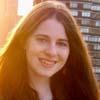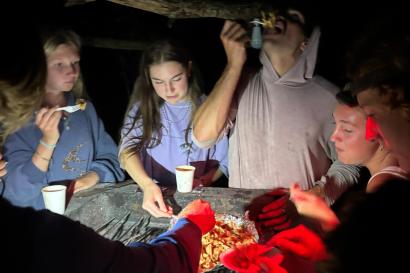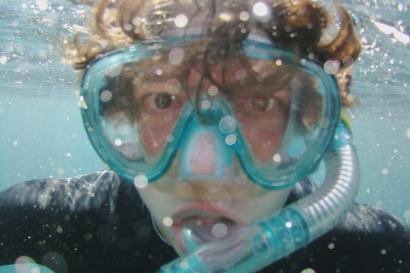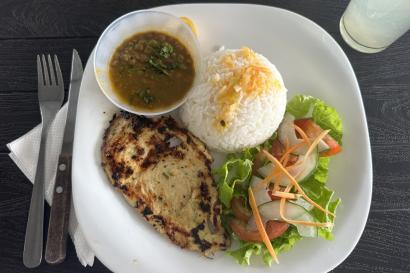As Passover has come and gone, I’m clearly behind on blogging, but nevertheless..
This post is dedicated to David and his family, who were nice enough to drive us all the way from the North side of Quito to the South late at night.
I’m more culturally Jewish than actually religious. That said, my family still celebrates the major Jewish holidays and I’ve been going to Seders with a ton of extended family members since I was a little kid. So when I found out through one of my classmates that there was an opportunity to go to a Seder in Quito, I jumped at the chance.
Katie and I took a bus to Carcelén, a sector of Quito in the far North, i.e. a pretty long journey from the Southern financial district where IES’ center is located. Nevertheless, we eventually made it. Upon arriving, we were starving and decided to get a snack, not knowing how long the Seder would be before we were actually served any food. Disclaimer: Katie and I might be the worse Jews ever. Prior to the Seder, we went to a local panadería and stuffed ourselves with bread. But since I’ve never kept kosher for Passover, I don’t feel too guilty;)
After snacking, we made our way to the synagogue. The security there is pretty high, although according to David, it used to be much higher. Once we were free to enter the synagogue courtyard (after being instructed not to take photos) we stepped into what may be one of the most beautiful places I’ve encountered in Ecuador (and I’ve had the fortune to see a lot of beautiful places). The synagogue had several arches, and the shadows cast on them would have made for some gorgeous photography. Alas, disobeying Ecuadorian security guards is not a good idea. The view from the synagogue was also incredible, especially since it was getting dark. We could see the sun set over the mountains, and everything was very quiet. It was amazing.
Entering the synagogue, we ended up going to a room upstairs where the Passover service would be held before the Seder. Having only ever been to the Seder part of Passover, this was an interesting experience. The community of Jews is not that large in Quito, so most people knew each other, but all were very warm and friendly, despite us being strangers. Later, when we met Sebastian, a man who works at the synagogue, he told Katie and I that the synagogue was our house and we could come back and use the pool and gym whenever we wanted (first thought: They have a pool?!). But seriously, more evidence for how kind and welcoming Ecuadorians are.
After the service, everyone headed downstairs to a large room with many tables. No one told us where to sit, so Katie and I chose a random table. At first it was just us, but then we were joined by several others: Aaron, another American, Sebastian, and a man named David, his wife and their young daughter. The Seder itself was not that different from the ones I’ve been to, but there were certainly still some differences, among which were:
•The Seder was (obviously) in Spanish (with some Hebrew mixed in). The rabbi was from Argentina, which made me really appreciate how easy Ecuadorian Spanish is to understand. Nevertheless, I was able to understand enough of the Argentine Spanish to get by.
•Instead of having the youngest child ask the Four Questions, everyone recited them together.
•At one point during the Seder, everyone was instructed to wash his or her hands. Not that this is solely an Ecuadorian tradition. Apparently the hand washing ritual is commonplace at most Seders, Katie and I just hadn’t heard of it before.
•Jeopardy! At the end of the Seder, the rabbi ran a Jeopardy game with questions about Passover. If you knew the answer, instead of simply raising your hand, you needed to have someone from your table be the first one to run up to the front of the room. Although Katie and I didn’t participate, it was fun to watch.
Overall, the Seder was a fantastic experience, and I think probably one of the most worthwhile things I’ve done in Ecuador. My one regret was that there was no chocolate covered Matzoh. But I think I’ll live.

Claire Fishman
<p><span style="color: rgb(29, 29, 29); font-family: Arial, Verdana, sans-serif; font-size: 12px; line-height: normal; background-color: rgb(237, 237, 237);">Claire Fishman is a junior at Brandeis University, majoring in Psychology. Outside of class, she enjoys singing with the university’s chorus and playing flute with a student orchestra. Her hobbies include reading, writing, cooking. Claire has traveled to Central America twice (Costa Rica and Honduras), but this will be her first time in South America. Despite having grown up in a large city, she loves spending time in nature, and looks forward to exploring the biodiversity of Ecuador. As someone who loves to travel and try new things, Claire is thrilled to be embarking on this adventure!</span></p>






